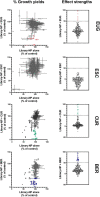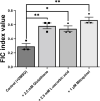Discovery of Natural Products With Antifungal Potential Through Combinatorial Synergy
- PMID: 35558105
- PMCID: PMC9087349
- DOI: 10.3389/fmicb.2022.866840
Discovery of Natural Products With Antifungal Potential Through Combinatorial Synergy
Abstract
The growing prevalence of antifungal drug resistance coupled with the slow development of new, acceptable drugs and fungicides has raised interest in natural products (NPs) for their therapeutic potential and level of acceptability. However, a number of well-studied NPs are considered promiscuous molecules. In this study, the advantages of drug-drug synergy were exploited for the discovery of pairwise NP combinations with potentiated antifungal activity and, potentially, increased target specificity. A rational approach informed by previously known mechanisms of action of selected NPs did not yield novel antifungal synergies. In contrast, a high-throughput screening approach with yeast revealed 34 potential synergies from 800 combinations of a diverse NP library with four selected NPs of interest (eugenol, EUG; β-escin, ESC; curcumin, CUR; berberine hydrochloride, BER). Dedicated assays validated the most promising synergies, namely, EUG + BER, CUR + sclareol, and BER + pterostilbene (PTE) [fractional inhibitory concentrations (FIC) indices ≤ 0.5 in all cases], reduced to as low as 35 (BER) and 7.9 mg L-1 (PTE). These three combinations synergistically inhibited a range of fungi, including human or crop pathogens Candida albicans, Aspergillus fumigatus, Zymoseptoria tritici, and Botrytis cinerea, with synergy also against azole-resistant isolates and biofilms. Further investigation indicated roles for mitochondrial membrane depolarization and reactive oxygen species (ROS) formation in the synergistic mechanism of EUG + BER action. This study establishes proof-of-principle for utilizing high-throughput screening of pairwise NP interactions as a tool to find novel antifungal synergies. Such NP synergies, with the potential also for improved specificity, may help in the management of fungal pathogens.
Keywords: Saccharomyces cerevisiae; Zygosaccharomyces bailii; crop pathogens; drug combinations; fungal pathogens; fungicide combinations.
Copyright © 2022 Augostine and Avery.
Conflict of interest statement
The authors declare that the research was conducted in the absence of any commercial or financial relationships that could be construed as a potential conflict of interest.
Figures







Similar articles
-
Novel Combinations of Agents Targeting Translation That Synergistically Inhibit Fungal Pathogens.Front Microbiol. 2018 Oct 4;9:2355. doi: 10.3389/fmicb.2018.02355. eCollection 2018. Front Microbiol. 2018. PMID: 30349511 Free PMC article.
-
Repurposing Nonantifungal Approved Drugs for Synergistic Targeting of Fungal Pathogens.ACS Infect Dis. 2020 Nov 13;6(11):2950-2958. doi: 10.1021/acsinfecdis.0c00405. Epub 2020 Nov 3. ACS Infect Dis. 2020. PMID: 33141557
-
Resistance in human pathogenic yeasts and filamentous fungi: prevalence, underlying molecular mechanisms and link to the use of antifungals in humans and the environment.Dan Med J. 2016 Oct;63(10):B5288. Dan Med J. 2016. PMID: 27697142 Review.
-
Novel, Synergistic Antifungal Combinations that Target Translation Fidelity.Sci Rep. 2015 Nov 17;5:16700. doi: 10.1038/srep16700. Sci Rep. 2015. PMID: 26573415 Free PMC article.
-
Candida and candidaemia. Susceptibility and epidemiology.Dan Med J. 2013 Nov;60(11):B4698. Dan Med J. 2013. PMID: 24192246 Review.
Cited by
-
The bioactivities of sclareol: A mini review.Front Pharmacol. 2022 Oct 3;13:1014105. doi: 10.3389/fphar.2022.1014105. eCollection 2022. Front Pharmacol. 2022. PMID: 36263135 Free PMC article. Review.
-
The impact of curcumin on livestock and poultry animal's performance and management of insect pests.Front Vet Sci. 2023 Feb 3;10:1048067. doi: 10.3389/fvets.2023.1048067. eCollection 2023. Front Vet Sci. 2023. PMID: 36816192 Free PMC article. Review.
-
Medicinal plant Miconia albicans synergizes with ampicillin and ciprofloxacin against multi-drug resistant Acinetobacter baumannii and Staphylococcus aureus.BMC Complement Med Ther. 2023 Oct 23;23(1):374. doi: 10.1186/s12906-023-04147-w. BMC Complement Med Ther. 2023. PMID: 37872494 Free PMC article.
-
The IV International Symposium on Fungal Stress and the XIII International Fungal Biology Conference.Fungal Biol. 2023 Jul-Aug;127(7-8):1157-1179. doi: 10.1016/j.funbio.2023.04.006. Epub 2023 May 11. Fungal Biol. 2023. PMID: 37495306 Free PMC article.
-
Baicalein combined with azoles against fungi in vitro.Front Microbiol. 2025 Mar 13;16:1537229. doi: 10.3389/fmicb.2025.1537229. eCollection 2025. Front Microbiol. 2025. PMID: 40182279 Free PMC article.
References
LinkOut - more resources
Full Text Sources
Miscellaneous

